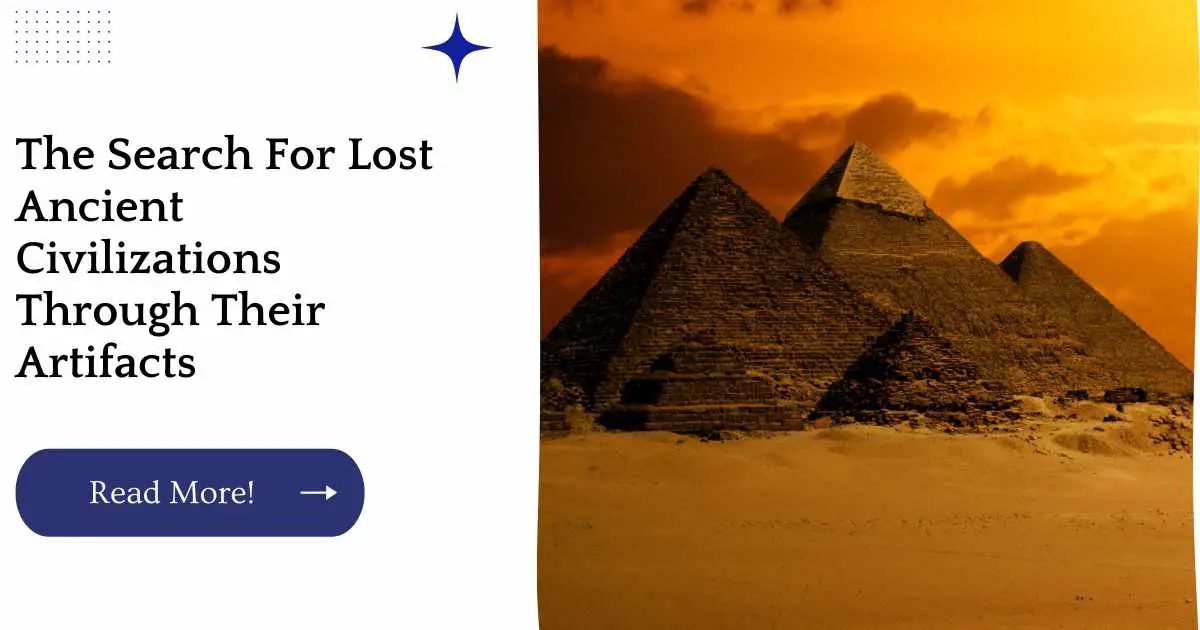The search for lost civilizations and their artifacts is an interesting one. It’s a bit like searching for a needle in a haystack, but the needle is somewhere in that haystack, so someone must find it!
| Takeaways |
|---|
| Archaeology is the study of human history and prehistory through the excavation and analysis of artifacts, structures, and other physical remains. |
| Archaeology is important because it allows us to better understand our past and how we got to where we are today. |
| Archaeologists use a variety of tools and techniques to excavate sites, including shovels, trowels, brushes, and sieves. |
| Archaeologists can uncover a wide variety of artifacts, including tools, pottery, jewelry, weapons, and artwork. |
| Archaeologists use technology such as x-rays, CT scans, and chemical analysis to better understand the composition and function of artifacts. |
In this post I’ll be talking about some of the most famous lost ancient civilizations that we know of, as well as some of their famous artifacts.
Bronze Age
The Bronze Age is a period in human prehistory distinguished by the use of bronze, and thus by the beginning of the Bronze Age, we mean the beginning of the use of bronze.
Bronze is a mixture of copper and tin. Copper occurs naturally as metal, but it has to be heated to high temperatures before it can be melted and shaped into objects, such as weapons or tools.
Tin occurs naturally as metal too, but it is not found in large enough quantities on Earth to make it practical to work with. Because of this fact, humans discovered how to extract tin from its ore in order to create bronze because without tin you can’t create a good product!
“Egypt has some of the most impressive ancient ruins in the world, from the Great Pyramids to the Luxor Temple. Learn more about the history behind these iconic structures by exploring our article on exploring the history behind ancient ruins in Egypt.”
Minoan culture
The Minoan culture was a prehistoric civilization that flourished during the Bronze Age in Crete (ca. 2700-1420 B.C.), spanning the Early, Middle and Late Bronze Ages.
The Minoan civilization has been dubbed as the first “modern” civilization by scholars due to its complex structure and advanced levels of art, literature, science and technology.
The Minoans were also among the first civilizations to establish trade routes with other countries outside their immediate region (in this case, Egypt).
Greek Artifacts
By now you’ve probably heard of Greek art, but let’s break it down into its subcategories. The most popular artifacts are Greek pottery, architecture, sculpture and vases.
Greek pottery is one of the most remarkable aspects of ancient Greece. Not only were they able to create beautiful pieces that were aesthetically pleasing but also functional—they could hold water! Many believe this is what led them to become so famous because it was such an important invention at the time.
Architecture can be found throughout each city in Greece as well as in other countries like Turkey or Italy which were influenced by Greek culture through colonization (i.e., when one country takes control over another).
“Ancient artifacts provide a window into the past, revealing insights into the cultures and societies that created them. Explore some of the most fascinating ancient artifacts from around the world by checking out our article on 15 fascinating ancient artifacts that tell the story of our past.”
Architecture includes things like buildings or gardens which hold meaning for people who visit them because they remind them of their heritage or history with that place.
Sculpture was used mainly for religious purposes even though we don’t know much about how exactly these sculptures were used back then because there isn’t much documentation available from those times either unfortunately.
Some scholars think they may have been used as offerings during festivals while others believe sculptures served more abstract purposes such as symbolism or representation which would explain why some are quite difficult to interpret without any context given!
“From the Pyramids to the Parthenon, ancient artifacts have fascinated people for centuries. Discover the fascinating stories behind these iconic structures by checking out our article on the history of ancient artifacts from the Pyramids to the Parthenon.”
Egyptian Artifacts
Egyptian Artifacts are among the most popular ancient artifacts. They are known for their intricate designs and use of colors.
In fact, much of Egyptian art is full of color and detail that makes it very recognizable to this day. These artifacts have been found in many parts of the world, making them extremely sought after by collectors who want to own a piece of this ancient civilization.
Roman and Byzantine Arifacts
Roman and Byzantine art is the art produced during the Roman, Byzantine and Greek Empires, which lasted from 27 BC to 1453 AD. The oeotokos type of icon was used to depict Mary holding her child Jesus. They used gold leafing in their mosaics to create amazing images on their walls.
Viking Artifacts
Viking Artifacts are the most common and most important artifacts found from the Viking Age. The Vikings were a Scandinavian people who raided, traded and explored in all parts of Europe, Asia and North America.
They lived in small communities or villages called “Houses”. These Houses were usually made of wood with a stone foundation to keep them strong.
The houses had steep roofs that sloped down towards each side of the house so that water would run off easier if it rained.
Inside these houses they kept their food supplies; meat, vegetables and fish as well as jars filled with beer which was made from fermented barley grain mixed with honey water plus herbs such as yarrow or heather flowers added for flavor (this is why we call it mead today).
“The search for lost ancient civilizations has captivated the minds of adventurers and scholars alike for generations. Explore the mysteries of these civilizations by reading our article on the search for lost ancient civilizations through their artifacts.”
Byzantine Empire Artifacts and Their Evolution with Time
Since the Byzantine Empire has been around for over 1,000 years, it’s no surprise that they have accumulated a lot of artifacts.
With this in mind, you may wonder why their art is so different from other ancient civilizations like the Egyptians or Mesopotamians. It turns out that there are many reasons for this difference.
The first reason is because of their location; since the Byzantine Empire was located in modern-day Turkey and Greece, most of their art focused on scenes from nature (i.e., animals).
The second reason is due to their religion; since Christianity was such an important part of Byzantine life, many sculptures depicted religious events or figures from the Bible (i.e., Jesus Christ).
Finally, there were also many artists who worked on creating beautiful mosaics during this period; these artworks often depicted plants and flowers as well as geometric shapes such as diamonds or triangles throughout them!
These three factors contributed greatly towards what makes Byzantine artwork so unique compared with other ancient cultures around them: namely because they focused more heavily on nature than people (although some still existed).
“The Rosetta Stone is one of the most famous artifacts in the world, providing the key to deciphering ancient Egyptian hieroglyphs. Learn more about this fascinating artifact and its history by reading our article on uncovering the secrets of ancient artifacts: the story of the Rosetta Stone.”
Conclusion
Artifacts are the remnants of lost civilizations and cultures. They tell us about the past and help us understand our history.
As technology advances, archaeologists are able to study these artifacts better than ever before in order to piece together how civilizations were formed, what they looked like during their prime time periods and what happened once they fell apart.
We hope that this article has given you some insight into how people lived thousands of years ago based on their surviving artworks!

Hi there! My name is Hellen James, and I’m here to talk to you about treasure hunting. I’ve been a fan of treasure hunting ever since I was a kid, and if you’re a fan of treasure hunting or just like the idea of finding a long-lost fortune, then this blog is for you.

